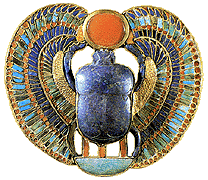Khepri — The winged scarab

Thus linking pharaoh to the eternal journey of the sun, and hence the power and mysteries of life and resurrection.
Cairo - Egyptian Museum
Ancient Egyptians observed a small beetle laboriously rolling a large ball of dung and then witnessed new life spontaneously arise from this same ball (the hatched lava of the scarab). A parallel was drawn between this apparent phenomenon and the first of their Gods, 'Atum' - self regeneration/creation and secondly with the journey of the sun god Re.
The scarab beetle was given the epithet of Khepri i.e. 'he who came forth from the earth' and worshiped as the rising sun i.e. dawn, synonymous with creation, self regeneration, resurrection. The distant sun was known as Harakhti, (hawk) and the full sun disc was 'Ra' (the cult deity of Heliopolis).
In Egyptian mythology there is a story of how Isis tricked Ra into revealing his many names - i.e. Kephri (dawn) Ra, (midday) and Atum (evening).
However so precious and powerful was the great name of Ra, the single name that would give Isis power over Ra, that it could not be revealed by spoken word. Instead Ra transported this knowledge directly to her heart and forbid her to reveal this name to anyone other than Horus. This legend explains the deifying of Pharaoh - personification of Horus on earth – Protector of the Black Land.
The following extract from the Book of the Dead chapter 83, explains the relationship of the scarab beetle with Atum, - creator and sun god, and the concept of self-regeneration-
...'I have soared as the primeval one soars' (Atum) I have become Khepri.
'I have grown as plants grow… I am the fruit of every god'
The sacred scarab was also used prodigiously in funerary rites and as a general protection amulet. Even today it remains one of the most familiar and popular of all Ancient Egyptian amulets.

Picture: Dewet/Images
The Egyptian dung beetle is anthracite-coloured and hails from the superfamily 'Scarabaeoidea' . The scarab is a particular sub-species referenced as a 'roller', indicating the natural behaviour of this beetle when it rolls the dung ball along the ground. Scarabaeoidea or the dung beetle are present in all continents in various sub-species the only exception being Antarctica.
© 2008 Juliet Le Page
Go back to History & Culture, or Home.






